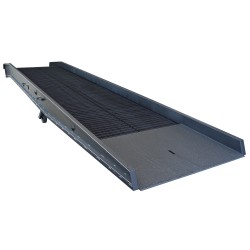We use cookies to make your experience better. To comply with the new e-Privacy directive, we need to ask for your consent to set the cookies. Learn more.
Yard Ramp Transportation and Positioning

-
Unload trucks manually.
This option carries high labor costs, has limited efficiency, and poses serious injury risks for workers. If you expect to handle pallet loads, this option isn’t realistic.
-
Build a new loading dock at your facility.
Knocking holes in potentially load-bearing walls requires major renovations (and associated expenses), and dock doors with wheel lock systems can run about $36,000 a piece. It might be more cost-effective to buy or rent a new space.
-
Invest in mobile yard ramps.
By far the most affordable of the options, portable ramps provide forklifts with access to trucks from anywhere in the yard. Some operations with permanent loading docks also own yard ramps for high-volume periods, or to stay on schedule when a dock leveler breaks down.
Ramps make the most sense for most facilities, but there’s one problem left: how do you position your ramp to get forklifts in and out of the trailer? Keep in mind that trailers are no longer set at standard heights; you'll need to position your ramp vertically once it's in place.
Luckily, quality ramps (like the BHS Yard Ramp) are easy to move with forklifts, and incorporate hydraulic hand pumps to adjust vertical placement. Two competing technologies affix wheeled yard ramps to lift trucks for transportation: fork clamps and tow bars. Both are available for the BHS Yard Ramp.
What to Know When Positioning Yard Ramps with Fork Clamps
As with any powered industrial equipment, safety is your first priority when transporting yard ramps. Make sure the clamps are securely attached to the ramp before beginning travel.
If you're pushing the yard ramp, be aware of limited visibility. In order to keep a gentle slope for loaded forklifts, yard ramps can be quite long — the BHS Yard Ramp creates a gentle slope with a length of 36 feet. Remember to keep an eye on the far end of your travel path.
You’ll also need to adjust the height of your fork clamp to keep weight centered on the ramp's wheels to prevent drag. Drive slowly, especially when approaching trailers. Once your yard ramp is in place, secure the safety chains before allowing traffic into the trailer.
What to Know When Moving Yard Ramps with Tow Bars
Tow bars hitch to the rear of a lift truck. Check the security of the connection at the base of the ramp before you start driving. As you pull the ramp into place, give yourself a much wider turning radius than usual. OSHA recommends reducing speed considerably during turns; remember this rule when towing yard ramps.
Be particularly cautious when traveling in reverse while tethered to a yard ramp. Always keep your eyes in the direction of travel, no matter which way you're headed. And — this bears repeating — never, ever take a turn on a grade. Even a limited slope can tip your vehicle over, dragging 36 feet of steel ramp with it.
If your facility doesn’t have a loading dock, yard ramps provide ground-to-truck access at a relatively low cost. Similarly, if you only expect to receive a few deliveries per day, a yard ramp may be the solution you're looking for. On the other end of the spectrum, large scale distribution centers can keep ramps in storage for quick backup when there's a problem with an existing bay. All you’ll need is a standard lift truck — fitted with a tow bar or a fork clamp — in order to position your yard ramp right where you need it the most.
References:
Allen, Ronald. “Prevent Trailer/Dock Separation Incidents.” Mhlnews. Penton, 23 Feb. 2012. Web. 23 Sept. 2015.
“Operating the Forklift: Load Handling.” OSHA. Occupational Safety & Health Administration, U.S. Department of Labor, n.d. Web. 23 Sept. 2015.
“Operating the Forklift: Traveling & Maneuvering.” OSHA. Occupational Safety & Health Administration, U.S. Department of Labor, n.d. Web. 23 Sept. 2015.
